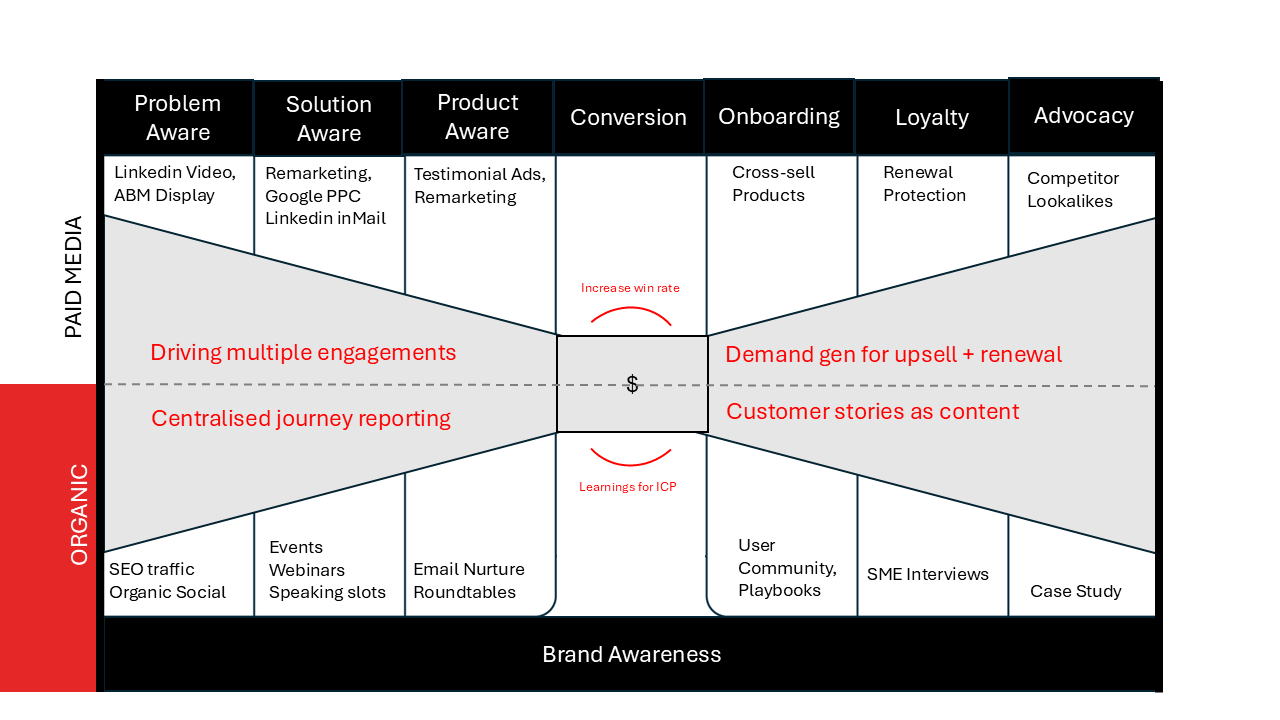Effective demand generation doesn’t just happen by chance. It relies on a clear, purposeful content strategy – one that maps to each stage of the buyer’s journey. When your content speaks to what your audience needs at the right moment, you’re not just sharing information – you’re building momentum toward conversion, loyalty, and long-term value.
This targeted approach ensures every asset you create works harder: guiding, educating, and supporting potential customers as they move from awareness to action. Here’s how to build a content strategy that drives results – turning interest into intent, and prospects into advocates.
The 4 key stages of the buyer journey
The buyer’s journey outlines the stages potential customers move through – from identifying a problem to making a purchase and beyond. Each stage reflects a shift in mindset, needs, and expectations.
By understanding this journey, you can align your content to meet buyers where they are, guiding them through their decision-making process with relevant, timely information. This not only improves lead nurturing but also increases the chances of conversion.
To do this well, it’s important to develop content that speaks directly to the priorities and challenges your audience faces at each stage. Here’s how to tailor your strategy across the four key phases of the buyer’s journey:

1. Awareness (problem aware)
In the awareness stage, buyers are just beginning to recognize they have a problem or unmet need. They’re diagnosing their situation and looking for clarity – not solutions. Your goal here is to educate and position your brand as a reliable, informed resource.
Use accessible formats like blog posts, infographics, and social content to explore common pain points and industry insights. With 56% of B2B buyers exploring new vendors for better features and 51% citing poor integration with existing systems, educational content that addresses these issues can build early trust and interest.
2. Consideration (solution aware)
Buyers in the consideration stage are actively researching solutions. They’re comparing approaches, evaluating providers, and looking for insight into the best path forward.
Shift your content to deeper, solution-oriented insights – think reports, case studies, webinars, and comparison guides. With 42% of B2B buyers consulting 4-6 sources (and 35% looking at up to 10), standing out requires both variety and depth.
3. Decision (product aware & conversion)
At the decision stage, buyers are ready to commit, but need assurance that they’re choosing the right vendor. Your content should help remove their remaining doubts and reinforce your credibility. Customer testimonials, pricing guides, product demos, and free trials can all help tip the balance.
With over 85% of decision-makers more likely to shortlist vendors they recognize and trust, this is the moment to make your value clear and tangible.
4. Post-sale (loyalty & advocacy)
After the sale, the focus shifts to long-term value. The goal here is retention, satisfaction, and advocacy.
Offer onboarding guides, support resources, and customer success content to help users get the most from your products. Loyalty programs and spotlighting customer stories can also turn satisfied users into brand advocates.
Adapting for long-term impact
Mapping content to the buyer’s journey isn’t a one-time task – it’s a continuous process shaped by changing buyer behaviors, business goals, and market conditions. To stay effective, regularly review your content’s performance. Track engagement, lead quality, and conversion rates, and use insights from A/B testing and audience feedback to refine your messaging and formats.
Challenges will crop up, from defining buyer personas and working within budget limits to balancing automation with personalization or aligning marketing with sales. At the same time, the landscape is shifting. Data privacy, emerging tech, and rising expectations for tailored experiences are reshaping how demand generation works.
By addressing these hurdles and embracing innovation, you can build a more resilient, effective demand generation strategy – one that adapts as the market shifts.
Conclusion: Building a strategy that lasts
Aligning content to the buyer’s journey is a powerful way to strengthen your demand generation efforts. By addressing the specific needs of your buyers at each stage, you create more engaging experiences and drive stronger results.
The potential ROI is clear: content marketing costs 62% less than traditional outbound methods, yet can generate up to three times the amount of leads. With over 5 billion people online today, the opportunity to boost your performance and connect with global audiences through relevant, timely content is bigger than ever.
Focus on understanding your audience, delivering consistent value, and refining your approach as needs change. With the right strategy, your content doesn’t just convert – it builds trust and fuels long-term growth.
Don’t just map the journey – master it. Partner with Inbox Insight to implement a data-driven demand generation strategy that engages your ideal prospects and accelerates growth.






